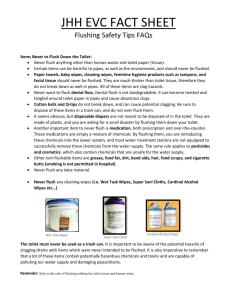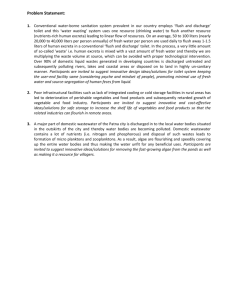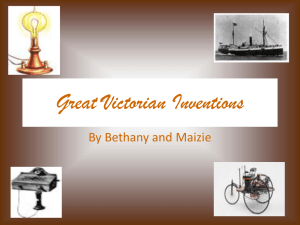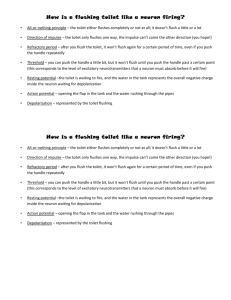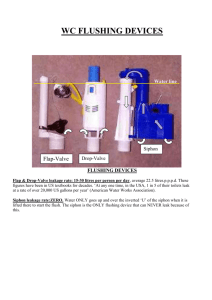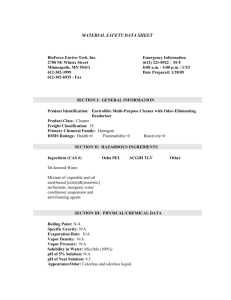language version - European Parliament
advertisement
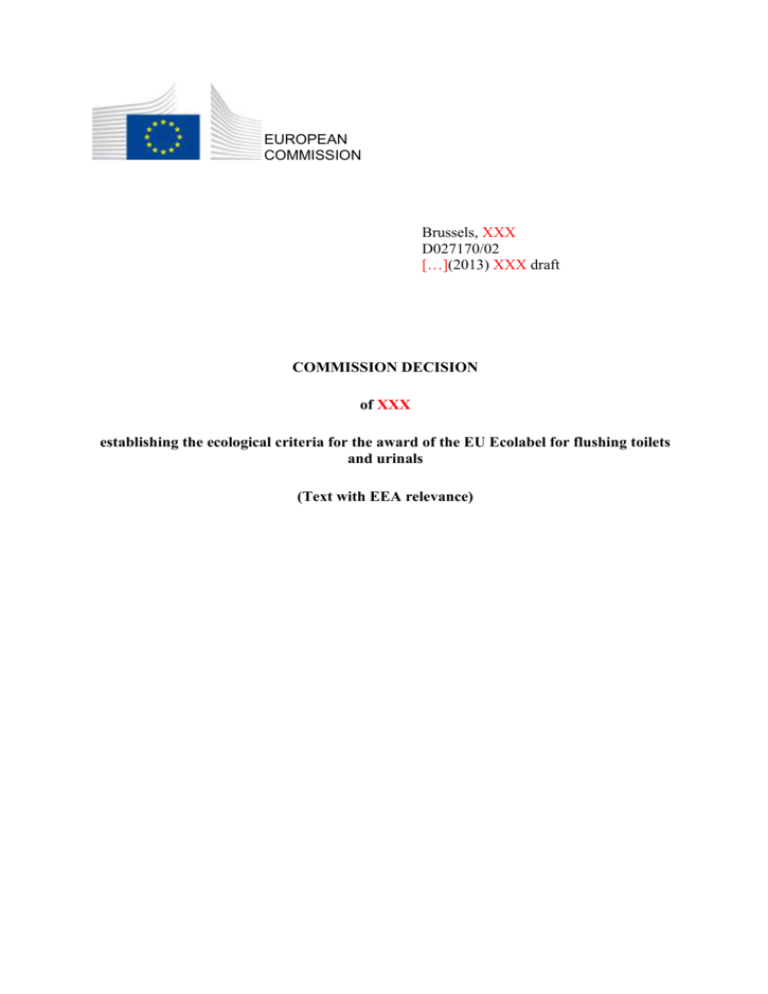
EUROPEAN COMMISSION Brussels, XXX D027170/02 […](2013) XXX draft COMMISSION DECISION of XXX establishing the ecological criteria for the award of the EU Ecolabel for flushing toilets and urinals (Text with EEA relevance) COMMISSION DECISION of XXX establishing the ecological criteria for the award of the EU Ecolabel for flushing toilets and urinals (Text with EEA relevance) THE EUROPEAN COMMISSION, Having regard to the Treaty on the Functioning of the European Union, Having regard to Regulation (EC) No 66/2010 of the European Parliament and of the Council of 25 November 2009 on the EU Ecolabel(1), and in particular Article 8(2) thereof, After consulting the European Union Ecolabelling Board, Whereas: (1) Under Regulation (EC) No 66/2010, the EU Ecolabel may be awarded to products which have a reduced environmental impact during their entire life cycle. (2) Regulation (EC) No 66/2010 provides that specific EU Ecolabel criteria are to be established according to product groups. (3) Since the consumption of water contributes significantly to the overall environmental impacts of domestic and non-domestic buildings, it is appropriate to establish EU Ecolabel criteria for the product group of ‘flushing toilets and urinals’. The criteria should, in particular, promote water-efficient products which contribute to a reduction in the consumption of water and associated other benefits such as reduction of energy consumption. (4) The measures provided for in this Decision are in accordance with the opinion of the Committee established by Article 16 of Regulation (EC) No 66/2010, HAS ADOPTED THIS DECISION: Article 1 1. The product group ‘flushing toilets and urinals’ shall comprise: flushing toilet equipment and urinal equipment as defined in Article 2. The product group shall cover products for domestic and non-domestic use. 2. The following products shall be excluded from the product group ‘flushing toilets and urinals’: 1 (a) toilet seats and covers, only when placed on the market or marketed independently from a flushing toilet or urinal equipment; (b) toilet equipment which do not use water, use chemical and water for flushing and toilets that require energy to aid the the flushing system. OJ L 27, 30.1.2010, p. 1-19 Article 2 For the purpose of this Decision, the following definitions shall apply: (1) ‘flushing toilet equipment’ means either a toilet suite, a toilet receptacle or a toilet flushing system; (2) ‘toilet suite’ means a sanitary appliance combining into a functioning unit a flushing system and a toilet receptacle for receiving and flushing away human urine and faeces and directing it into a drainage system; (3) ‘toilet receptacle’ means a sanitary appliance for receiving and flushing away human urine and faeces and directing it into a drainage system; (4) ‘urinal equipment’ means either a urinal suite, a urinal, a flush-free urinal or a urinal flushing system; (5) ‘flushing urinal equipment’ means either a urinal suite, a urinal or a urinal flushing system; (6) ‘urinal suite’ means a sanitary appliance combining into a functioning unit a flushing system and a urinal for receiving and flushing away urine and directing it into a drainage system; (7) ‘urinal’ means a sanitary appliance for receiving urine and water used for flushing and directing both into a drainage system; (8) ‘slab urinal’ means a sanitary appliance with or without flushing system comprising a floor channel and a slab or sheet fixed to a wall, for receiving urine and water used for flushing and directing both into a drainage system; (9) ‘flush-free urinal’ means a sanitary appliance for receiving urine and directing it into a drainage system, which functions without water; (10) ‘flushing system’ means, for both flushing toilet and flushing urinal equipment, either a flushing cistern with integral warning pipe connection – or a device deemed to be a no less effective device and inlet/outlet devices, or a pressure flush valve; (11) ‘water-saving device’ means a flushing device that permits a part of the full flush volume to be delivered either as double-action mechanisms (interruptible) or doublecontrol mechanisms (dual flush); (12) ‘full flush volume’ means the total volume of water discharged from the flushing system during a flush cycle; (13) ‘reduced flush volume’ means the part of the full flush volume of water discharged by a water-saving device during a flush cycle no greater than two thirds of the full flush volume; (14) ‘average flush volume’ means the arithmetic average of one full flush volume and three reduced flush volumes calculated by following the methodology set out in Appendix 1 to the Annex; (15) ‘on-demand flush control’ means a flushing device of a sanitary appliance, which can be operated either manually by the user through a handle, lever, button, foot pedal or any equivalent flush actuator, or by a sensor detecting the use of the sanitary appliance; (16) ‘adjusting device’ means a device which allows the full flush volume and, if relevant, the reduced flush volume of a flushing system to be adjusted; Article 3 The criteria for awarding the EU Ecolabel under Regulation (EC) No 66/2010 for a product falling within the product group ‘flushing toilets and urinals’ defined in Article 1 of this Decision as well as the related assessment and verification requirements are set out in the Annex. Article 4 The criteria and the related assessment and verification requirements set out in the Annex shall be valid for four years from [insert date: the date of adoption of this Decision]. Article 5 For administrative purposes, the code number assigned to the product group ‘flushing toilets and urinals’ shall be 41. Article 6 This Decision is addressed to the Member States. Done at Brussels, For the Commission Janez POTOČNIK Member of the Commission ANNEX EU ECOLABEL CRITERIA AND ASSESSMENT REQUIREMENTS Criteria for awarding the EU Ecolabel to flushing toilet and urinal equipment: 1. Water efficiency 2. Product performance 3. Excluded or limited substances and mixtures 4. Sustainably managed wood as raw materials 5. Product longevity 6. Reduced end-of-life impacts 7. Installation instructions and user information 8. Information appearing on the EU Ecolabel. Table 1 indicates the applicability of the different criteria to each category of flushing toilet and urinal equipment. Specific assessment and verification requirements are indicated for each criterion. Where the applicant is required to provide declarations, documentation, analyses test reports, or other evidence to show compliance with the criteria, these may originate from the applicant or their suppliers or both. Where possible, the testing shall be performed by laboratories that meet the general requirements of European Standard EN ISO 17025 or equivalent. Where appropriate, test methods other than those indicated for each criterion may be used if the competent body assessing the application accepts their equivalence. Where appropriate, competent bodies may require supporting documentation and may carry out independent verifications. The applicant shall declare the product’s compliance with the legal requirements of the country (countries) in which it is intended to be placed on the market. In test standards, toilet suites, toilet receptacles, urinals and flushing systems are distinguished by class or type, or both. The relevant class(es) or type(s) of the product shall be declared to the competent body assessing the application and all the tests to be performed shall be done for each class and/or type declared by the applicant according to the relevant standard. Table 1. Applicability of the different criteria to each category of flushing toilet and urinal equipment Flushing toilet and urinal equipment Toilet suites Criteria Toilet receptacles Toilet flushing systems Urinal suites Urinals Flushfree urinals Urinal flushing systems 1(a) – Full flush volume x x x x x x 1(b) – Water saving x x x x x x 1(c) – Average flush volume x x x 1(d) – Flush volume adjustment x x x x 2(a) – Flushing system requirements x x x x 2(b) – Flush performance x x x x 2(c) – Flush-free urinal requirements x 3(a) – Hazardous substances and mixtures x x x x x x x 3(b) – Substances listed in accordance with Article 59(1) of Regulation (EC) 1907/2006 of the European Parliament and of the Council2 x x x x x x x 4 – Sustainably managed wood as raw materials x x x x x x x 5(a) – Reparability and availability of spare parts x x x x x x x 5(b) – Warranty x x x x x x x 6 – Reduced end-of-life impacts x x x x x x x 7 – Installation instructions and user information x x x x x x x 8 – Information appearing on the EU Ecolabel x x x x x x x 2 OJ L 396, 30.12.2006, p. 1. Criterion 1. Water efficiency (a) Full flush volume The full flush volume, independent of the water pressure, of flushing toilet and flushing urinal equipment, when placed on the market, shall not exceed the value presented in Table 2. Table 2: Maximum limit for full flush volume of flushing toilet and flushing urinal equipment Product Full flush volume [l/flush] Flushing toilet equipment 6.0 Flushing urinal equipment 1.0 Assessment and verification: the applicant shall declare that the product complies with these requirements, and specify the nominal full flush volume (in l/flush) of the product, together with the results of tests conducted in accordance with the testing procedure indicated in the respective EN standards for the given kind of product (see Table 3). For slab urinals, the full flush volume refers to the water flushed over 60 cm width of continuous wall. Table 3: EN standards for measuring the full flush volume of flushing toilet and urinal equipment Product Standard Standard title Toilet suites and toilet receptacles EN 997 WC pans and WC suites with integral trap Urinal suites and urinals EN 13407 Wall-hung urinals - Functional requirements and test methods Flushing systems made of a flushing cistern EN 14055 WC and urinal flushing cisterns Flushing systems made of a manual pressure flush valve EN 12541 Sanitary tapware – Pressure flushing valves and automatic closing urinal valves PN 10 Flushing systems EN 15091 made of a contact-free pressure flush valve (b) Sanitary tapware - Electronic opening and closing sanitary tapware Water saving Toilet suites delivering a full flush volume of more than 4.0 litres and toilet flushing systems shall be equipped with a water-saving device. When placed on the market, the reduced flush volume, independent of the water pressure, delivered when the water-saving device is operated shall not exceed 3.0 l/flush. Toilet receptacles shall allow the use of a water-saving device, of which the reduced flush volume, independent of the water pressure, delivered when the water-saving device is operated shall not exceed 3.0 l/flush. Urinal suites and urinal flushing systems shall be equipped with an individual on-demand flush control. For slab urinals with flushing system , there shall be an individual on-demand flush control for not more than 60 cm width of continuous wall. Urinals shall allow the use of an individual on-demand flush control. Slab urinals without flushing system shall allow individual on-demand flush controls to be placed in not more than 60 cm width of continuous wall. Any sensor-based flush control shall prevent any false triggering and ensure that the flush is delivered only after the actual use of the product. Assessment and verification: the applicant shall declare that the product complies with those requirements and provide documentation describing the technology or device applied in the product. For flushing toilet equipment, the applicant shall specify the reduced flush volume (in l/flush) of the product, together with results of tests conducted in accordance with the testing procedure indicated in respective EN standards for the given kind of product (see Table 4). For products equipped with sensor-based flush control, the applicant shall provide a brief description of the measures taken when designing the product to prevent false triggering and ensure flush actuation only after actual product use. Table 4: EN standards for measuring the reduced flush volume of flushing toilet equipment Product Standard Standard title Toilet suites and toilet receptacles EN 997 WC pans and WC suites with integral trap Toilet flushing system made of a flushing cistern EN 14055 WC and urinal flushing cisterns (c) Average flush volume The average flush volume of flushing toilet equipment, when placed on the market, calculated by following the methodology set out in Appendix 1 shall not exceed 3.5 l/flush. Toilet suites delivering a full flush volume of 4.0 litres or less are exempted from this requirement. Assessment and verification: the applicant shall declare that the product complies with those requirements and specify the calculated average flush volume (in l/flush) of the product together with the results of tests conducted in accordance with the methodology set out in Appendix 1. (d) Flush volume adjustment Flushing systems shall be equipped with an adjusting device so that the flush volumes can be adjusted by the installer to take into account the local conditions of the drainage system. The full flush volume after adjustment according to installation instructions shall not exceed 6 l/flush for flushing toilet equipment or 4 l/flush if the toilet suite is not equipped with a water-saving device, and 1 l/flush for flushing urinal equipment. The reduced flush volume after adjustment according to installation instructions shall not exceed 3 l/flush for flushing toilet equipment. In the case of flushing systems made of a flushing cistern, the maximum full flush volume after adjustment shall be indicated on the flushing cistern by a water line or a water mark. Assessment and verification: the applicant shall declare that the product complies with those requirements and provide documentation describing the technology or device applied in the product. Criterion 2. Product performance (a) Flushing system requirements Flushing systems shall comply with the requirements of the respective EN standards listed in Table 5. The sections of the relevant EN standards in Table 5 below concerning the full flush and reduced flush volumes are excluded from this criterion. Assessment and verification: the applicant shall declare that the product complies with those requirements and provide the results of tests conducted in accordance with the testing procedure indicated in the respective EN standards for the given kind of product (see Table 5). Table 5: EN standard compliance for the flushing system Flushing system Standard Standard title Toilet and urinal flushing cisterns EN 14055 WC and urinal flushing cisterns Toilet and urinal manual pressure flush valves EN 12541 Sanitary tapware – Pressure flushing valves and automatic closing urinal valves PN 10 Toilet and urinal contact-free pressure flush valves EN 15091 Sanitary tapware - Electronic opening and closing sanitary tapware (b) Flush performance The flush performance of toilet and urinal suites, toilet receptacles and urinals shall comply with the requirements of the respective EN standards listed in Table 6. Assessment and verification: the applicant shall declare that the product complies with those requirements and provide the results of tests conducted in accordance with the testing procedure indicated in the respective EN standards for the given kind of product (see Table 6). Toilet suites and toilet receptacles not covered by any EN standard shall demonstrate flush performance levels similar to those of an equivalent class and type covered by Standard EN 997. In that case the applicant shall provide results of tests conducted in accordance with the testing procedure indicated in Standard EN 997 for products of equivalent class and type. Urinal suites and urinals not covered by any EN standard shall demonstrate flush performance levels similar to those of an equivalent class and type covered by Standard EN 13407. In that case the applicant shall provide the results of tests conducted in accordance with the testing procedure indicated in Standard EN 13407 for products of an equivalent class and type. Table 6: EN standard compliance for the flushing performance of the product Product Standard Standard title Toilet suites and toilet receptacles EN 997 WC pans and WC suites with integral trap Urinal suites and urinals EN 13407 Wall-hung urinals - Functional requirements and test methods (c) Flush-free urinal requirements Flush-free urinals shall meet the requirements defined in Appendix 2. Assessment and verification: the applicant shall declare that the product complies with those requirements and provide the results of tests conducted in accordance with the testing procedure set out in Appendix 2. Any equivalent methodology demonstrating that the requirements set out in Appendix 2 are met shall also be accepted. Criterion 3. Excluded or limited substances and mixtures (a) Hazardous substances and mixtures According to Article 6(6) of Regulation (EC) No 66/2010 the EU Ecolabel may not be awarded to any product, or any article of it as defined in Article 3(3) of Regulation (EC) No 1907/2006 or homogenous part of it that contains substances meeting the criteria for classification with the hazard statements or risk phrases as specified in Table 7 in accordance with Regulation (EC) No 1272/2008 of the European Parliament and of the Council 3 or Council Directive 67/548/EC4, or substances referred to in Article 57 of Regulation (EC) No 1907/20065. In case the threshold for classification of a substance or mixture with a hazard class differs from the one of a risk phrase than the former prevails. The risk phrases in Table 7 generally refer to substances. However, if information on substances cannot be obtained, the classification rules for mixtures apply. Substances or mixtures which change their properties through processing and thus become no longer bioavailable, or undergo chemical modification in a way that removes the previously identified hazard are exempted from criterion 3 (a). Table 7: Hazard statements and Risk Phrases 3 4 5 Hazard Statement Risk Phrase H300 Fatal if swallowed R28 H301 Toxic if swallowed R25 H304 May be fatal if swallowed and enters airways R65 H310 Fatal in contact with skin R27 H311 Toxic in contact with skin R24 H330 Fatal if inhaled R23/26 H331 Toxic if inhaled R23 H340 May cause genetic defects R46 H341 Suspected of causing genetic defects R68 OJ L 353, 31.12.2008, p. 1. OJ 196, 16.8.1967, p. 1. OJ L 396, 30.12.2006, p. 1. H350 May cause cancer R45 H350i May cause cancer by inhalation R49 H351 Suspected of causing cancer R40 H360F May damage fertility R60 H360D May damage the unborn child R61 H360FD May damage fertility. May damage the unborn child R60/61/60-61 H360Fd May damage fertility. Suspected of damaging the unborn child R60/63 H360Df May damage the unborn child. Suspected of damaging fertility R61/62 H361f Suspected of damaging fertility R62 H361d Suspected of damaging the unborn child R63 H361fd Suspected of damaging fertility. Suspected of damaging the unborn child. R62-63 H362 May cause harm to breast fed children R64 H370 Causes damage to organs R39/23/24/25/26/27/28 H371 May cause damage to organs R68/20/21/22 H372 Causes damage to organs through prolonged or repeated exposure R48/25/24/23 H373 May cause damage to organs through prolonged or repeated exposure R48/20/21/22 H400 Very toxic to aquatic life R50 H410 Very toxic to aquatic life with long-lasting effects R50-53 H411 Toxic to aquatic life with long-lasting effects R51-53 H412 Harmful to aquatic life with long-lasting effects R52-53 H413 May cause long-lasting harmful effects to aquatic life R53 EUH059 Hazardous to the ozone layer R59 EUH029 Contact with water liberates toxic gas R29 EUH031 Contact with acids liberates toxic gas R31 EUH032 Contact with acids liberates very toxic gas R32 EUH070 Toxic by eye contact R39-41 Concentration limits for substances or mixtures which may be or have been assigned the hazard statements or risk phrase listed in Table 7, meeting the criteria for classification in the hazard classes or categories, and for substances meeting the criteria set out in points (a), (b) or (c) of Article 57 of Regulation (EC) No 1907/2006, shall not exceed the generic or specific concentration limits determined in accordance with Article 10 of Regulation (EC) No 1272/2008. Where specific concentration limits are determined they shall prevail over the generic ones. Concentration limits for substances meeting the criteria set out in points (d), (e) or (f) of Article 57 of Regulation (EC) No 1907/2006 shall not exceed 0.1% weight by weight. The final product shall not be labelled with an hazard statement.. For flushing toilet equipment and urinal equipment, the substances/components in Table 8 are exempted from the obligation in Article 6(6) of Regulation (EC) No 66/2010 following application of Article 6(7) of the same Regulation: Table 8: Derogated substance/components Substance/component Hazard statements and risk phrases Articles with weight below 25 g All hazard statements and risk phrases Homogeneous parts of complex articles with All hazard statements and risk phrases weight below 25 g Nickel in stainless steel of all types H351, H372 and R40/48/23 Electronic components of flushing toilets and All hazard statements and risk phrases urinals equipment, which fulfil the requirements set out in Article 4 of Directive 2011/65/EU of the European Parliament and of the Council (6) Assessment and verification: for the product or any article or homogenous part of it, the applicant shall provide a declaration of compliance with criterion 3 (a), together with related documentation, such as declarations of compliance signed by their suppliers, on the nonclassification of the substances or materials with any of the hazard classes associated to the hazard statements referred to in Table 7 in accordance with Regulation (EC) No 1272/2008, as far as this can be determined, as a minimum, from the information meeting the requirements listed in Annex VII to Regulation (EC) No 1907/2006. This declaration shall be supported by summarized information on the relevant characteristics associated to the hazard statements referred to in Table 7, to the level of detail specified in Sections 10, 11 and 12 of Annex II to Regulation (EC) No 1907/2006. Information on intrinsic properties of substances may be generated by means other than tests, for instance through the use of alternative methods such as in vitro methods, by quantitative structure activity models or by the use of grouping or read-across in accordance with Annex XI to Regulation (EC) No 1907/2006. The sharing of relevant data across the supply chain is strongly encouraged. The information provided shall relate to the forms or physical states of the substance or mixtures as used in the final product. For substances listed in Annexes IV and V to Regulation (EC) No 1907/2006, which are exempted from registration obligations under point (a) and (b) of Article 2(7) of that Regulation a declaration by the applicant shall suffice to comply with criterion 3 (a). (b) Substances listed in accordance with Article 59(1) of Regulation (EC) No 1907/2006 No derogation from the exclusion in Article 6(6) of Regulation (EC) No 66/2010 shall be given concerning substances identified as substances of very high concern and included in the list provided for in Article 59(1) of Regulation (EC) No 1907/20067, present in mixtures, in an 6 7 OJ L 174, 1.7.2011, p. 88. http://echa.europa.eu/chem_data/authorisation_process/candidate_list_table_en.asp article or in any homogeneous part of a complex article in concentrations > 0.1%. Specific concentration limits determined in accordance with Article 10 of Regulation (EC) No1272/2008 shall apply in cases where the concentration is lower than 0.1%. Assessment and verification: reference to the list of substances identified as substances of very high concern shall be made on the date of application. The applicant shall provide a declaration of compliance with criterion 3 (b), together with related documentation, including declarations of compliance signed by the material suppliers and copies of relevant Safety Data Sheets for substances or mixtures in accordance with Annex II to Regulation (EC) No 1907/2006 for substances or mixtures. Concentration limits shall be specified in the safety data sheets in accordance with Article 31 of Regulation (EC) No 1907/2006 for substances and mixtures. Criterion 4. Sustainably managed wood Wood or wood-based parts used in flushing toilets and urinals may be recycled or virgin material. Virgin wood shall be covered by valid sustainable forest management and chain of custody certificates issued by an independent third party certification scheme such as FSC, PEFC or equivalent. However, where certification schemes allow mixing of certified material and uncertified material in a product or product line, the proportion of uncertified material shall not exceed 50 %. Such uncertified material shall be covered by a verification system which ensures that it is legally sourced and meets any other requirement of the certification scheme with respect to uncertified material. The certification bodies issuing forest and/or chain of custody certificates shall be accredited/recognised by that certification scheme. Assessment and verification: the applicant shall provide appropriate documentation indicating the types, quantities and origins of wood or wood-based parts used in flushing toilets and urinals. Where virgin wood is used, the product shall be covered by valid forest management and chain of custody certificates issued by an independent third party certification scheme, such as PEFC, FSC or equivalent. If the product or product line includes uncertified material, proof should be provided that the uncertified material is less than 50 % and is covered by a verification system which ensures that it is legally sourced and meets any other requirement of the certification scheme with respect to uncertified material. Criterion 5. Product longevity (a) Reparability and availability of spare parts The product shall be designed in such a way that its exchangeable components can be replaced easily by the end-user or by a professional service engineer, as appropriate. Information about which elements can be replaced shall be clearly indicated in the information sheet provided in print or in electronic format, or both. The applicant shall also provide clear instructions to enable the end-user or trained experts, as appropriate, to undertake basic repairs. The applicant shall further ensure that original spare parts or their equivalent are available for at least ten years from the date of purchase. Assessment and verification: the applicant shall declare that the product complies with those requirements and provide a sample or samples of the product information sheet provided in print or in electronic format, or both. (b) Warranty The product shall be covered by a warranty for repair or replacement of a minimum of five years. Assessment and verification: the applicant shall declare that the product complies with those requirements and provide a sample of the warranty terms. Criterion 6. Reduced end-of-life impacts Plastic parts with a weight above or equal to 25 g shall be marked in accordance with the requirements of Standard EN ISO 11469 so that materials can be identified for recycling, recovery or disposal during the end-of-life phase. Flush-free urinals shall either use a ready biodegradable fluid or operate completely without fluid. Assessment and verification: the applicant shall declare that the product complies with those requirements. Additionally, for flush-free urinals, the applicant shall provide documentation describing the technology used and, when a fluid is used, a test report demonstrating the ready biodegradability of the fluid, following the definition and test methods provided for in the “Guidance on the Application of the CLP Criteria”(8) according to Regulation (EC) No 1272/2008. Criterion 7. Installation instructions and user information The product shall be accompanied by relevant installation and user information, which gives all the technical details needed for a proper installation and provides advice on the product's proper and environmentally friendly use, as well as its maintenance. As a minimum, the installation instructions and user information shall include instruction and information on the following points on the packaging or on documentation accompanying the product in print or in electronic format: (a) (b) 8 proper installation instructions, including: - in the case of toilet receptacles, urinals and flushing systems placed on the market independently, information on which products they shall be combined with to make a full functioning unit that is water efficient; - information on which class(es) or type(s), or both the product has been tested for; - information on the specific operating pressures that the product is suitable for; - information on which drainage system types according to Standard EN 12056 the product can work with; - information describing how to adjust the flush volumes as well as the consequences in terms of residual water level and filling level; - a note mentioning the need to consult the relevant national and local regulations before installation of the products; information communicating that the main environmental impact is related to consumption of water, and advice on how rational use can minimise the environmental impact, in particular information on proper product use to minimise the consumption of water; http://echa.europa.eu/documents/10162/13562/clp_en.pdf (c) information communicating that the product has been awarded the EU Ecolabel, together with a brief, specific explanation as to what this means, in addition to the general information provided alongside the EU Ecolabel logo; (d) the full flush volume in l/flush (tested as indicated in Criterion 1(a)); (e) in the case of flushing toilet equipment equipped with or allowing the use of a water saving device, the reduced and average flush volumes in l/flush (tested as indicated in Criterion 1(b) and 1(c), respectively); (f) in the case of toilet receptacles and urinals placed on the market independently, information communicating that the product has to be combined with a suitable flushing system, which has an ecolabel, in order to make a full functioning unit that is water efficient, in particular the full flush volume and, if relevant, the reduced and average flush volumes of the flushing system to be combined with shall be indicated; (g) in the case of flushing systems placed on the market independently, information communicating that the product has to be combined with a suitable toilet receptacle and/or urinal, which has an ecolabel, in order to make a full functioning unit that is water efficient, in particular the full flush volume and, if relevant, the reduced and average flush volumes of the toilet receptacle and/or urinal to be combined with shall also be indicated; (h) recommendations on the proper use and maintenance of the product, mentioning all relevant instructions, particularly: - advice on maintenance and use of products; - information about which spare parts can be replaced; - instructions concerning the replacement of washers and other fittings if the product leaks; - advice on product cleaning with appropriate tools and cleaning agents in order to prevent damage to the product surface; (i) for flush-free urinals, instructions on the maintenance regime, including, if relevant, information on how to preserve and maintain the replaceable cartridge and how to change it and when, and a list of service providers for regular maintenance. (j) For flush-free urinals, appropriate recommendations for the disposal of the replaceable cartridges shall be provided, in particular detailing any take-back scheme(s) in place; (k) recommendations on appropriate disposal at the product’s end-of-life. Assessment and verification: the applicant shall declare that the product complies with those requirements and provide a sample or samples of the user information or a link to a manufacturer's website containing this information or both. Criterion 8. Information appearing on the EU Ecolabel The optional label with text box shall contain the following text: – high water efficiency and reducing waste water; – with this ecolabelled product you save water and money; – reduced end-of-life impacts; The guidelines for the use of the optional label with the text box can be found in the “Guidelines for the use of the EU Ecolabel logo” on the website: http://ec.europa.eu/environment/ecolabel/documents/logo_guidelines.pdf Assessment and verification: the applicant shall declare that the product complies with those requirements and provide a sample of the label. Appendix 1: Methodology to measure and calculate the average flush volume 1. Test methods Mount the flushing toilet or equipment following the assembling instructions delivered by the manufacturer. In the case of toilet receptacles, the equipment shall be mounted with a test flushing system, as described in relevant EN standards. Install the mounted equipment on a firm flat horizontal or vertical surface as appropriate. Connect the inlet valve to a water supply having a static water pressure of (0.2 ± 0.01) MPa ((2 ± 0.1 bar) and open the water supply valve. Leave the water supply open during all the tests. Operate the full flush mechanism control, collect the water delivered and discard it. 1.1 Evaluation of the full flush volume Operate the full flush mechanism control and collect the water delivered. Measure the volume using a calibrated container. Record the measured volume. Perform the test three times. If there are differences in the volumes delivered, calculate the full flush volume (Vf) as the arithmetic mean for the three recorded volumes. 1.2 Evaluation of the reduced flush volume Operate the reduced flush mechanism control and collect the water delivered. Measure the volume using a calibrated container. Record the measured volume. Perform the test three times. If there are differences in the volumes delivered, calculate the reduced flush volume (Vr) as the arithmetic mean for the three recorded volumes. 2. Calculation of the average flush volume Calculate the average flush volume (Va) as follows: Va = (Vf + (3 Vr)) / 4 Appendix 2: Requirements to be met by flush-free urinals and test methods 1. Flush-free urinal requirements Flush-free urinals shall pass all the following tests: – load resistance test, – draining test, – leak tightness test, and – backflow prevention of foul air and water test. 2. Flush-free urinal test methods 2.1 Load resistance test Flush-free urinals shall be deemed to comply with the load resistance test if they meet the requirements on load resistance passinga static load test similar to those defined in EN 13407. Any equivalent method shall be accepted. 2.2 Draining test Flush-free urinals shall be deemed to comply with the draining test if they meet the requirements on the draining of water by passing a draining of water test similar to those defined in EN 14688. Given that the test in EN 14688 is defined for wash basins, any test adaptation to fit the purpose of testing flush-free urinals shall be accepted. Any equivalent method shall be accepted. 2.3 Leak tightness test Flush-free urinals shall be deemed to comply with the leak tightness test if they ensure that all fluid poured into them is evacuated only through the outlet connection. Coloured water shall be used for this test to help detect any potential leakage. Any equivalent method shall be accepted. Alternately, flush-free urinals shall be deemed to comply with the leak tightness test if they meet the requirements on water absorption by passing a determination of water absorption test similar to those defined in EN 13407. Any equivalent method shall be accepted. 2.4 Backflow prevention of foul air and water test Flush-free urinals shall be deemed to comply with the backflow prevention of foul air and water test if they meet the requirements on odour tightness and resistance of the water seal to pressure similar to those defined in EN 1253-1 by passing, respectively, an odour tightness test and a resistance of the water seal to pressure test similar to those defined in EN 1253-2. Any equivalent method shall be accepted.

